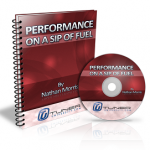Without adding forced induction, many people want to know how much horsepower their car can make. Typically there's some pretty wild theories about how to get there and what that figure might be. However, there's a very straight forward way to figure out the theoretical maximum for your street car (as long as boost is not involved).
Volumetric efficiency is a term that (basically) refers to the ability of an engine to convert air and fuel into power. More accurately, it's the engine's ability to make use of the available air around it.
When we fit a better intake, we increase volumetric efficiency somewhat by reducing the restriction that the intake system is placing on the engine's ability to pump in fresh air.
When we fit a free flowing exhaust system, we increase VE by getting spent gasses out of the engine more efficiently so new combustible gasses can enter the combustion chamber.
Engines also have what could be called a VE curve. The VE of an engine varies over the rev range and all engines are more or less efficient at various points along that rev range.
Camshafts can significantly alter the VE curve of the engine. The VE curve usually closely follows the torque curve of the engine if you were to graph them together. The reason is that torque output is directly linked to VE, and engines are variably efficient. This means that they breathe better or worse at different RPMs and throttle angles.
So what?
Well, the cool thing we're going to talk about today is how we can figure out what level of volumetric efficiency we'd have to achieve to get to a certain power output. Because 100% is perfect, we know that if a power output we want is well beyond 100% that we can't achieve that power output (at a specified RPM) unless we add forced induction.
Now, some very clever engineers have achieved VEs beyond 100 by taking advantage of some fairly complex intake tuning. I will talk about that at another time, but in short, they tune the intake length to take advantage of pressure waves in the intake system to help them cram more than atmospheric pressure into the cylinders.
That said, the highest VEs achieved by even the most clever race teams is somewhere around 115%. If you can achieve higher, you have either miscalculated or you need to start applying to F1 and NASCAR championship teams.
Now, first the formula and then a good example or two.
REQUIRED VE = ( 9411 x HP x BSFC ) / (DISPLACEMENT x RPM)
HP = horsepower
BSFC = brake specific fuel consumption (for naturally aspirated cars, 0.45 is a reasonable estimate)
Displacement = displacement in cubic inches
RPM = well, you know.
Example: Let's say we want to know how much horsepower a 2JZ-GE engine from an IS300 can produce without raising its redline.
The 2JZ-GE engine has about 183 cubic inches of displacement. The stock redline is ~ 6450 RPM.
If we wanted to make 300HP (at the crankshaft), the formula would look like this:
(9411*300*0.45)/(183*6450) = 1.07 (x 100 to get percentage) = 107%
So in other words, getting 300HP even at the very peak of the engine's factory rev range is going to be impossible without investing a significant sum of money (if it's even possible at all). 107% VE is an exceptional design.
Using our BMEP equation from a previous article, (224 kW * 1200) / (2.998L*6450RPM) = 13.9 - which is well beyond the BMEP of even an F1 car. Wow.
Then we consider that we'd make 300hp right at redline, which means that power is basically meaningless as up until then we're making less than 300hp and you never want to make peak power at redline (again, for reasons beyond the scope of this article). For now let's say this would be a relatively slow 300hp engine. Typically, we want peak power to occur somewhere low in the working rev range and be maintained for as long as possible.
So, what kind of power would this engine make if we were to have a VE that's more reasonable? Well, with some simple Algebra, we can find out what power we could make assuming a 100% VE figure at redline.
1 (100%) = (9411*HP*0.45) / (183 * 6450)
Doing some Algebra we get:
1 = 4234.95HP / 1180350
OR in a layman's formula:
(Displacement*rpm) / 4234.95 = HP
* Assuming a BSFC of 0.45 (which is a great estimate for general NA purposes)
Which for this engine gives us a figure of 278.72hp. 278.72 hp is achievable with exceptional modifications at factory red line. Again calculating the BMEP for this engine would give us something like 12.9 which is still exceptionally high and probably unreasonable once more.
We also would never want to have peak power at redline, as we said, so let's give it a more reasonable value such as the factory peak power rpm of 5800. Using the formula above, we see that if we could achieve 100% VE, at 5800rpm, we'd only produce 250hp with that VE and that RPM value. That set of values has a BMEP of 12.8 by the way, but at least in the ball park of a highly developed race engine.
So what's the point? Well, first of all, we can see from crunching some numbers that producing 300hp with this engine, especially with a factory rev limit, is going to be impossible and if not, extremely impractical. This could save a lot of guys in the "all motor" forum for this car, a LOT of money - just doing some quick math to see the practicality of their goals.
So what about raising the rev limit? Glad you asked. Unfortunately, raising a rev limit significantly is a sure fire way to significantly reduce an engine's life. Running an engine beyond its designed RPM will significantly increase cylinder wear and stress, tax the oiling system and frankly most cylinder heads and camshafts that you would want to run on a street car are not going to be terribly efficient at seriously high rpm anyway. As with everything, there's always a trade off and when we're dealing with street cars, we have to remember these trade offs.
But, for giggles, let's say we can get away with a 1000rpm rev limit increase on this engine, and we raise it up to 7450 rpm. Using our formula again, we find that the required VE at 7450 to achieve 300hp would be only ~ 93% which - is certainly achievable with a good cylinder head and camshaft profile. Granted, I say achievable in a theoretical sense. There may be many factors preventing you from achieving that sort of VE - factors that cannot be changed by any amount of modification. BMEP would also be acceptable at around 12.01.
The downside is, again, we'd be making that power right at redline and in the real world this would mean very disappointing performance, realistically, we'd still have to rev out another 1500 rpm or so to get maximum benefit from this peak power value at 7450. An engine making far less power at lower revs for longer would easily trounce this theoretical engine.
Peak power is not everything and the sooner you get over that notion, the better of you'll be. AVERAGE power in the operating rev range (ie, from where the downshift drops you to where the shift occurs) is king.
So these formulas are EXCEPTIONALLY useful at figuring out the reasonableness of claims and theories. In other words, if someone on the forum is claiming to make 280 hp at the wheels with a stock redline on their 2JZ-GE, you can easily raise the BS flag and stir up the typical forum argument.... but at least you'll know.
You may also raise the BS flag on yourself when you begin to consider your goals and how achievable they might be, or perhaps, you'll find out they are easily achieved!
To summarize this little example analysis, I believe that without significant (and I do mean significant and EXPENSIVE) modifications, the 2JZ-GE engine cannot make more than around 250hp on a factory block, without some form of forced induction. This seems to be supported in the reported dyno results of many 2JZ-GE owners, coming in right around 215-225whp. Obviously that number isn't set in stone, but it's a fairly close limit. Can a race engine produce more? Absolutely. Can you daily drive a race engine? ya, but I wouldn't want to do it.
This sort of calculation can easily be done on any engine and if you're being reasonable, you can logically work out what the limits of your engine are.
There are definitely different rules for a pure race engine. However, there is only so much room THERE as well. BMEPs can be higher on race engines, and, VEs can approach 110% or so. However, that's about it.
In closing, please use these formulas to evaluate your goals. You will save yourself a great deal of money and you can focus on doing things that will help you actually achieve your goals.
Extremely Limited Time Offer - 3 Days Only
Get a MASTERS DEGREE in Performance Tuning from the BEST in the Field for ONE low package price
For 3 days only, get ALL of our PREMIUM (not available anywhere else) Tuner University Courses featuring some of the greatest minds in motorsports:
- Top 10 Performance Myths Class (MP3 and Edited Transcript) - $29.95 value
- Performance on a Sip of Fuel Class (MP3 and class manual) - $69.95 value
- Header Design Secrets with John Grudynski (MP3 and transcript) - $69.95 value
- Dirty Secrets of Oil with Ryan Stark (MP3 and transcript) - $69.95 value
- Engine Tuning Secrets with Ben Strader of EFI University (MP3 and Transcript) - $69.95 value
Get all of the above courses (many of which not currently available anywhere else) for one single price of just $309.75 $69.95. A HUGE package savings.
You can also buy any of these individually through our resource center, but I don't know why you would as this is basically the whole store for the price of just 1 course. You'll get the MP3 recordings of each class as well as a transcript or companion manual with each course and you'll be able to download them all INSTANTLY.





